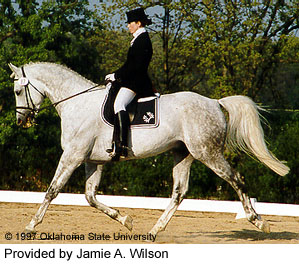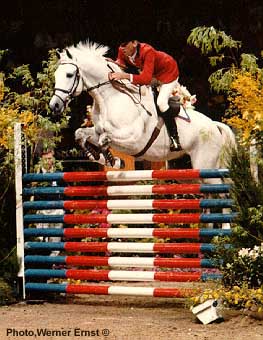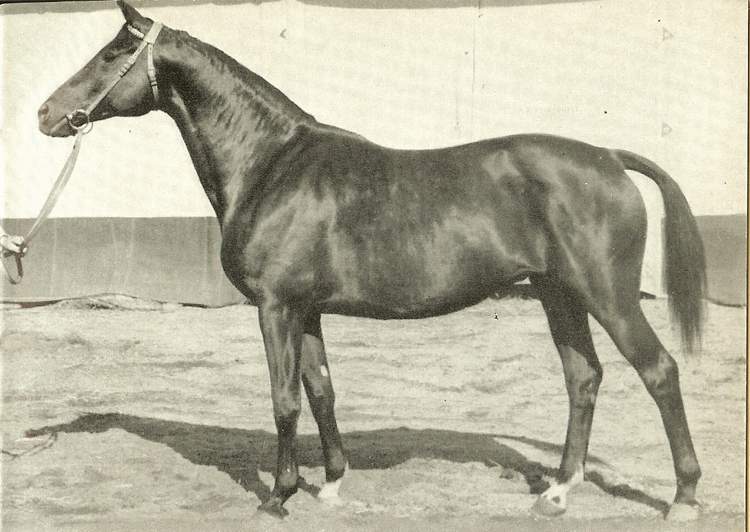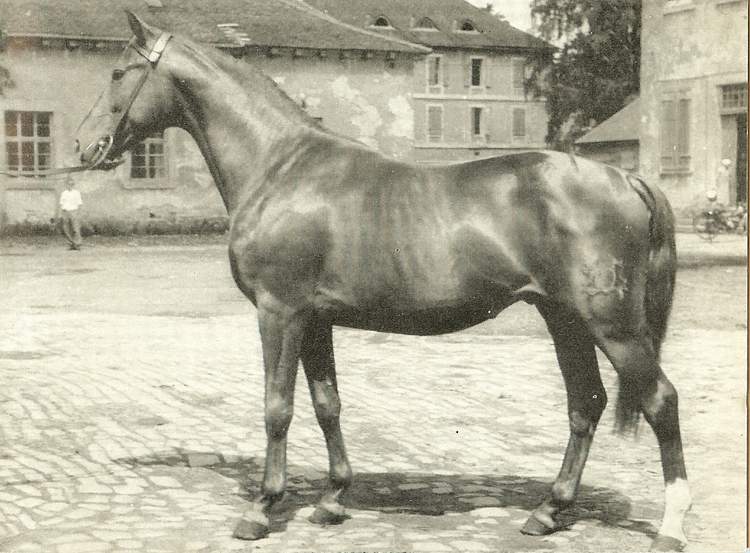

Trakehner
Formerly the East Prussian


Introduction: If you have any comments or suggestions, please click here. I believe the horse pictured jumping is Abdullah, perhaps the most famous Trakehner of modern times.
Names: Trakehner. I believe it was named after the stud in East Prussia where it originated. Also at one time called the East Prussian or the East Prussian-Trakehner strain.
Origin: Bred
mainly in Poland
and Germany, but came originally from East Prussia.
On the colonization of the province of East Prussia in 1341,
the German Order of Knights established studs for both heavy and light horses (Konik)--and
it is from the latter that the present-day Trakehnen is descended.
Trakehnen was founded in 1732 by the soldier king Friedrick Wilhelm I.
Since 1786, systematic breeding based on the local East Prussian breed, using
Arabs and Thoroughbreds on a large scale. Up to 1945 practically all the
horses in the German Army were of East Prussian Breed. After the
capitulation and the loss of East Prussia, and with it the majority of its
horses, the scattered remains were gathered together by the Trakehner
Association, and the breed reconstructed from the remains. Between the two
world wars, horses were exported all over the world. They make excellent
steeple-chasers, event and show jumpers.
A fine riding horse, generally considered to be the most
perfected breed in Germany. The Trakehner Stud was founded in 1732 by
Frederick William I of Prussia. By 1786, systematic breeding on a large
scale was carried on in East Prussia. (One source claimed that in its
physical make up the Trakehner is practically identical with the English or
American Thoroughbred. I tend to doubt this, since if that were the case
it could not well be claimed that the Trakehner is the ideal competition
horse--the Thoroughbred would be!)
Breeding: Up
till 1945, breeding area and studs were in East Prussia. Central stud at
Trakehnen. Also at the district studs of Rastenburg, Georgenburg,
Gudwallen, Marienwerder, Braunsberg, and numerous private studs (such as Weedern,
Szirguponen, Kilgis, Dombrovka, Dvarishka, Schlobitten, Wohnstorf, Steinort,
Geisseln, etc.).
At present (1960s) breeding of pure-bred East Prussian
Trakehner horses is under the management and control of the Trakehner
Association, Hamburg-Farmsen, at the studs at Hunnesrück, Birkhausen, Rantzau,
Schmoel, Panker, Webelsgrund and a number of smaller establishments.
All Trakehner horses are registered with the Trakehner
Association whose brand--double elk antler on near-side thigh--they bear, as are
horses bearing the original Trakehner or other East Prussian brand, whose papers
are missing as a result of the Second World War.


(I thought it would be of some interest to include the above two pictures of a mare (on the left) and a stallion (on the right) from when these horses were still called East Prussians. You may be able to make out the above mentioned antler brand on the stallion's thigh.)
Description:
Action: Very correct, spirited movements. Long walking stride. Long, light, level trot; no knee action of any kind; great galloping and jumping ability.
Body: Beautifully set-on, light and long neck. High, long withers and long, sloping shoulders. Powerful, well-sprung back, carries saddle well. Long, oblique, well-muscled quarters. Well-muscled loins. Deep, but usually not very broad chest.
Color: Can be bay, brown, black or chestnut. Separated by colours for breeding in the former stud at Trakehnen. Chestnut, bay, black and mixed herds. Mostly sorrel, brown, or black.
Head: Find and noble, sometimes with long, drooping ears.
Legs usually very clean and correctly placed.
Size: 16-16.2 hands. 16 to 17.2 hands. 60-68 inches; 1000-1400 pounds.
Temperament: Gentle but brave. Lively temperament and good character.
Features: Versatile and courageous. Next to the Thoroughbred, the top quality riding horse in Germany today. A light, noble, elegant, very well-bred saddle horse. Tough, hardy, easy feeder, has stamina, is active. Very hardy constitution.
Uses: Works as a farm and cavalry horse. Good at jumping and dressage. So many countries are finding these the ideal animals for show-jumping and eventing. They excel in riding sports, harness, and farm work. Used to be the ideal remount for the light cavalry; the best military horse and hunter.
Accomplishments: In
the winter of 1945, word arrived at the famous Trakehner Stud in East Prussia
that the Russians
were near. With no time to lose, a nucleus of in-foal
mares were harnessed to field-wagons and driven westward, while an old man and
two boys set off on foot to herd about thirty stallions in the same
direction. The stud and remaining Trakehner and East Prussian horses were
eventually taken over by the Poles, who breed them now as Masuren. Those
that reached safety provided the core for new, post-war Trakehner studs, now
producing a more elegant type, which has much influence on other breeds.
The endurance of Trakehner horses can never be questioned
after that desperate 900 mile trek. The mares were unshod, and
for two-and-a-half months contended with snow, ice and frequent bombing.
They mostly remained harnessed through the nights, standing outside ready to
move off directly if danger threatened. Fodder was so scarce that the
majority of the expected foals were born dead of starvation. Less than one
thousand pure-bred horses from East Prussia escaped, but many countries now have
Trakehner studs.
Curiosities:
Profiles:
Conclusion: